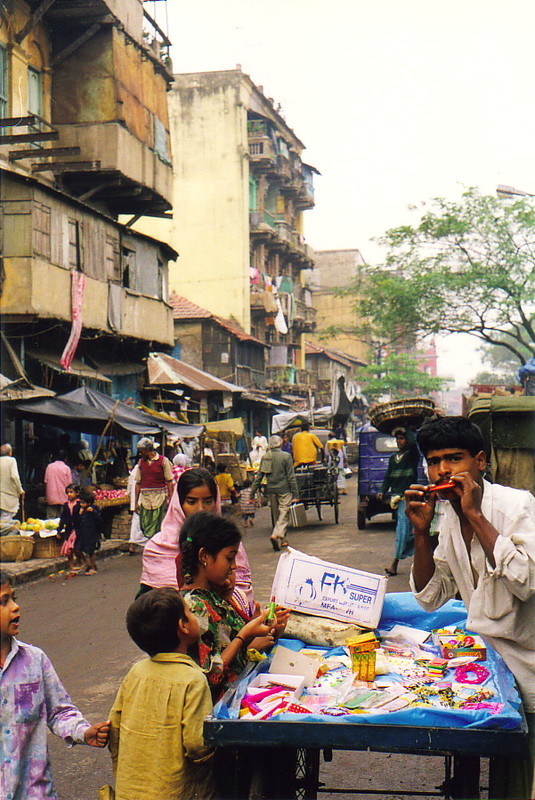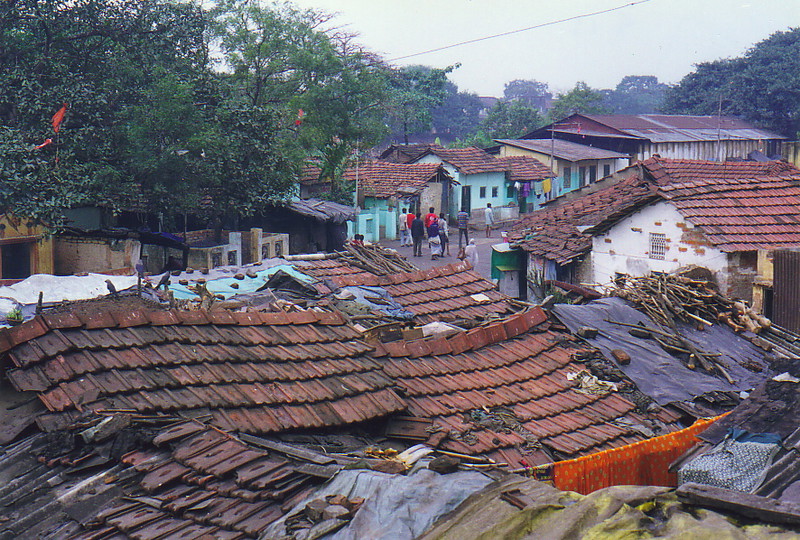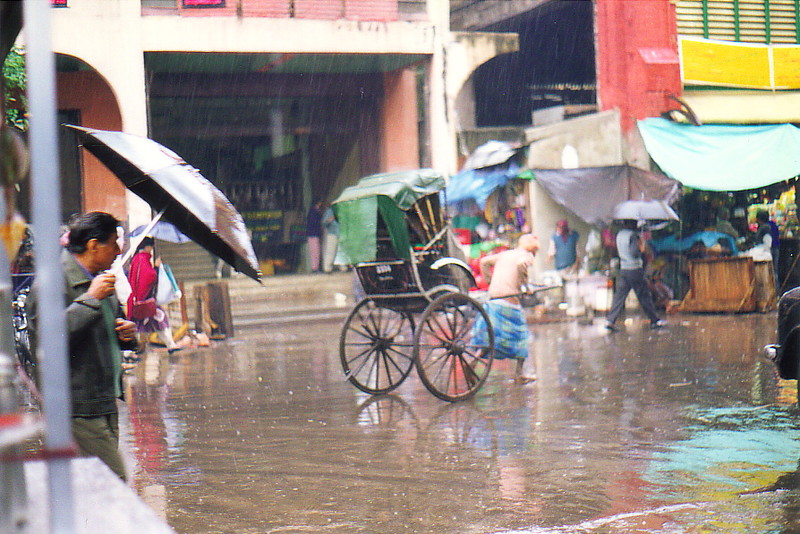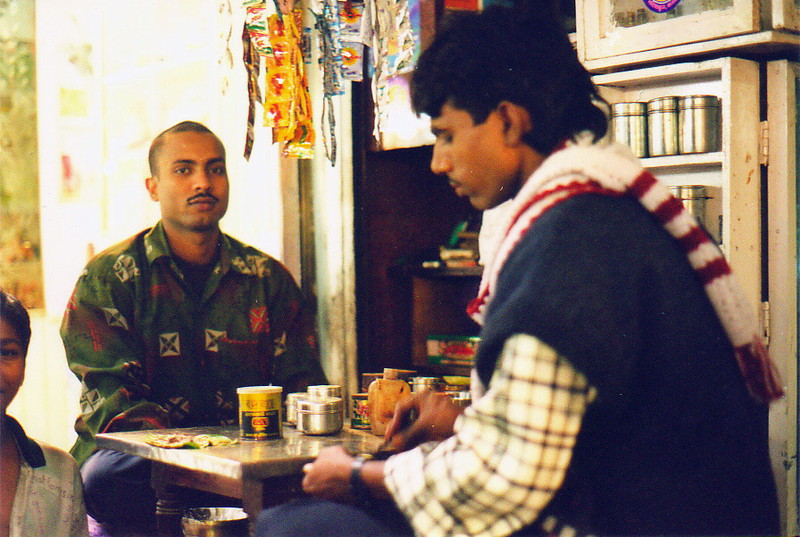
Calcutta has an image problem. Ask most people what springs to mind when you mention the capital of West Bengal, and the images are of black holes, excessive pollution, slums, Mother Theresa and human tragedy. The guidebooks recommend that if this is your first visit to India, you shouldn't make Calcutta your point of arrival. I can see why, but in my case it was exactly what I needed to blow the cobwebs of complacency away; it has to be the best introduction to a country I've ever experienced. I instantly found myself getting a buzz from travelling again...
Calcutta is a calamity of humanity. From the minute you step off the plane, it's in your face, shocking and surprising at every turn. India strikes you hard; all your preconceptions are inadequate. I can conjure up images in my mind of slums, beggars, pollution and sheer filth, but there's a huge difference between imagination and reality, and however well prepared you are, the real thing makes you stop and think. On the other hand, I wasn't so much shocked as fascinated; I've been gradually introduced to the squalor of Asia by travelling through various degrees of the developing world, and now that I'm in the developing world, I'm finding I can handle it. I'm actually more shocked at my lack of surprise than I am by the squalor itself; I feel almost guilty to be able to accept such shocking scenes without feeling overly emotional. Such is the effect of long-term travel.

But it is true what they say: India is a different world. From the sheer mass of humans to the frenetic pace of life, it's like nothing you have ever seen before; it's an almost contradictory combination of rushing around like headless chickens and sitting back and doing absolutely nothing, a mix that only the Indians seem to have perfected. Calcutta is, of course, a particularly good example of Indian mayhem, and it seems it has always been this way. In 1803 Lord Valentia wrote, 'The town of Calcutta is at present well worthy of being the seat of our Indian Government both from its size and from the magnificent buildings which decorate the part of it inhabited by Europeans. The Black Town is a complete contrast to this as well can be conceived. Its streets are narrow and dirty; the houses... resembling the cabins of the poorest class in Ireland... Chowringhee, an entire village of palaces, forms the finest views I have ever beheld in any city.'
There's still plenty of British splendour under the pollution... and what pollution! The difference between London and Bangkok is as great as the difference between Bangkok and Calcutta, and where Bangkok's haze hung around like a naughty schoolkid, mischievous but not necessarily a real threat, Calcutta's should come with a government health warning. If you manage to find a spot where you can see for a short distance – on the River Hooghly or in the Maidan, for example – then, well, you can't see for a short distance. Bridges and tall buildings appear as if they're floating in cumulonimbus, and as for the sun, it's a distant, hazy memory. I've managed to catch Calcutta in the wet, but the daily downpours don't shift the smog, they merely add to the chaos.

Calcutta is fairly flat, so when it rains, it's a disaster. The streets are pretty squalid anyway, but I'm surprised by the sheer amount of mud in this precipitous city. Whether they're digging up the roads and piling up dirt on the roadside, only to have it wash all over the street, or whether it's a slum area where bitumen is an alien concept, the mud is ubiquitous. Coupled with the rains are temperatures that reflect the time of year: Calcutta is freezing. I thank the stars that I decided to hold on to my sleeping bag, and I'm snuggling up at night while my roommate, a Frenchman called Eric whom I befriended in the airport, is freezing his proverbials off under a thin blanket.
So the roads are mud traps, the weather is shocking and the pollution solid enough to be claiming squatters' rights, but Calcutta is a fascinating place to explore. Every road holds new thrills, and every attempt to do something fairly simple results in an experience that leaves you dumbfounded. For example, visiting the bank to change my travellers cheques took ages; I knew Indian banks were slow, and indeed I managed to get my cheques changed in a pretty efficient half-an-hour, but it's an edifying sight watching the man fill out three or four forms, all in triplicate, and then file them round to various people for signatures, checks and goodness knows what else. The British bureaucratic legacy lives on, but in India, red tape has been transformed into an art form.
Images of Calcutta
How can you describe a mad place like Calcutta? I'll simply pick out some of the crazier things I saw as I wandered around the streets, getting splattered in mud, cow dung and exhaust fumes:
-
The driving is worse here than anywhere else I have been; Indians make Indonesians look like One Careful Woman Owners. One-way streets aren't actually one-way, they simply mean you should be more careful about oncoming traffic, or – as most Indians seem to interpret the rules – one-way streets simply mean you should sound your horn continuously. Come to think of it, sounding your horn continuously is a prerequisite on any street, and Calcutta has to be one of the best places in the world to study the Doppler Effect; indeed, nine out of ten motorbikes have such hot-wired horns that their headlights dim when the horn goes off. Listening to the traffic is like a particularly energetic session at Crusty the Clown's Funny Car Show: horns blare, honk, buzz, fart, whoop, rattle, ring and even screech like sirens, and behind the horns are multi-coloured rust buckets that look like they might fall apart at any moment. I'd heard that India was a circus, but I didn't realise it was meant literally.
-
There are cows all over the place, acting as natural rubbish hoovers and creating traffic havoc when they decide to sit down and chew the cud in the middle of a main thoroughfare. Cows are sacred to the Hindus – you won't find many beef steaks in India – and they have free rein over the whole country. Hitting a cow with your car is worse karma than running over a human, so the cows are left to wander all over the place, leaving havoc in their wake. Never have the rural and urban clashed so strangely as in the rolling meadows of Calcutta.
-
Homelessness is a fact of life for a huge number of Calcutta residents, and it's simply amazing how every possible spot of land is used for makeshift tents, hard concrete beds and communal cooking collectives. Beggars tug at your clothes, looking pathetic and insisting more persistently than beggars in Southeast Asia. There are huge beggar rackets, and giving to Mother Theresa's mission is a much better way of helping the poor, but although you can put the problem out of your mind, there's no danger of being able to avoid it. Walking round Calcutta's backstreets is like starring in a telethon.
-
The street – indeed, any open space – is the toilet, kitchen and bedroom for lots of people. Everywhere you go there are people pissing and shitting in the middle of the road; there are people washing themselves at the public water pumps, almost naked and all soaped up, desperately trying to shift the dirt that must be so ingrained after years in the pollution; and there are people cooking their lunch right next to drains that house more germs than a biological warhead. It's no wonder that India is disease-ridden; education about cleanliness is, well, scant.
-
But, conversely, there are lots of smart middle class people in Calcutta. One must assume that tucked away in the depths of the city are reasonable housing estates, pleasant flats and relatively unpolluted areas, because the middle class is clean, pressed and eminently presentable, even if a lot of the clothes look like they've been rescued from a sixties retrospective fashion shoot. There's an underground train system, of which only one north-south line is completed, but it's efficient and relatively clean, and there are plenty of adverts around for computers, stereos and televisions, while dead dogs pile up under the hoardings, swelling up in the heat like cows on Australian highways. It's the contrast between these different ways of life that brings the problem home; if you explore a place where everyone is poor, as would be the case in a poor village in the middle of Africa, the concept of poverty is more palatable, but when you see the incredibly poor and the comparatively well off squashed together on the same pavement, it makes the problem much more obvious, and much more unjust.
-
The 450m-long Howrah Bridge, which spans the River Hooghly, is the busiest bridge in the world, and walking across it has to rate as one of the strangest experiences in Calcutta. The cars, buses and taxis are manic as they converge on the cantilevered construction, and every day 60,000 vehicles drone over the river, as well as an uncountable number of pedestrians. While I was walking over to the railway station to buy a timetable, I saw a taxi collide with a truck, losing its front offside wheel and sparking to a halt in the middle of the road. The truck kept going, the taxi passengers got out and simply hailed another taxi, and the taxi driver was left with a wrecked car and an angry bunch of crazy locals all swerving to avoid him and his taxi, none of whom thought it a good idea to stop and help. I left him to it; watching the pilgrims bathing in the river while their friends defecated just upstream from them was entertaining enough.
-
Howrah Station, Calcutta's main railway station, is incredible. It's an imposing building housing dozens of lines, and trains run from here to every corner of the subcontinent. India's trains are simply superb; a relic from the British Raj, the railways are masterfully run, rarely run on time but always run, and are the best way to get around this vast country. India has over 60,000km of tracks, and every day 7000 passenger trains run, carrying over 10.5 million passengers and connecting 7100 stations; not surprisingly, Indian Railways is the world's largest single employer, with over 1.6 million staff. Howrah Station is a bustling hovel, with naked beggars sleeping in the middle of the main hallway while porters rush around shouting orders and blowing whistles for no discernible reason. Waiting for a train isn't boring in India; it might be draining, but it's certainly not boring.
-
The railway system isn't the only relic from the British Raj; Calcutta was the first capital of British India – Delhi didn't take over until 1912 – and it has its fair share of pompous Victorian monuments. The most impressive is the huge Victoria Monument at the southern end of the Maidan; it's an imposing white marble monstrosity that sums up the decadence and pomp of the British Empire in one phallic thrust. Out front is a statue of Queen Victoria during her fat-Elvis stage, and inside is a statue of the relatively unknown slim Victoria; if the second statue's anything to go by, she was quite a looker in the early years, so perhaps Albert wasn't such a blind bugger after all. Still, even in fat old crone mode, old Vic's an impressive sight, presiding over a city that's totally Indian and as far from Britain as you can possibly get.
Inside the Victoria Monument is a very good museum that explains the history of Calcutta, from its founding in 1690 by Job Charnock to the present day. I found it fascinating, and thoroughly enjoyed being bounced around the displays by the Indian tourists thronging to this piece of the Raj; Indians seem to thrive on human pinball, and if you're a female you should be prepared for a fair amount of fondling in the process. Not for the first time I thanked the stars I was born with an appendage...
-
In front of the Victoria Monument and the nearby St Paul's Cathedral is the large grassy expanse of the Maidan. The Maidan is locally known as the Lungs of Calcutta, and it's a very apt description; as you walk through the rubbish, cow dung and fading grass, you can almost hear it wheeze. I couldn't help thinking of the aftermath of the Glastonbury festival, when the rubbish of a hundred thousand stoned revellers is all that remains of the year's biggest music event, and like the aftermath of Glastonbury, there are a number of casualties curled up on the floor in the Maidan. The difference is that most Glastonbury visitors have a home to go to, and it only happens once a year; in contrast the Maidan is for real, and it's there every day of the year.
-
The Maidan is also home to a large number of sports clubs: over there is the ICI Sports Club, and tucked away in another corner is The Telegraph Sports Club. It seems amazing to have such a proliferation of health clubs in an area where jogging for half an hour will do you more damage than inhaling liquid tar, but I guess they hail from the days before exhaust fumes and chemical pollution. It's probably safer to stay at home with a six-pack, a pizza and the remote control than to try to improve your biceps on the Maidan.
-
At first glance, the Indians are a wonderfully friendly bunch, and their English is the best I've come across since Australia and New Zealand. Conversations can still feel a bit like a customs form – name, occupation, country of origin, length of stay, and so on – but most of the locals have enough English for you to be able to have a real conversation with them once the niceties are out of the way. This is a delightful change from Indonesia and Thailand, where the language barrier is more challenging.
-
Indian attitudes are, however, baffling. If you have to do something, then reserve at least five times the amount of time that you'd need in the West; banks, shops and transport seem to happen at a snail's pace, as if everyone's running through glue. Once you accept this, it's a lot of fun trying to get things done. One fellow traveller whom I met in Calcutta was trying to find an Enfield motorcycle to tour round on, and I joined him for an exploratory trip round the mechanical shops of Calcutta. One shop he visited was shut because 'it is raining', and another told him to come back tomorrow because 'we can't find the bike just yet', despite the fact that he was already coming back from the day before. And ask an Indian whether something is true, and you'll get a wobble of the head; the wobble can mean 'yes', 'no', 'I don't know', or any combination of the above. It can frustrate the hell out of you, but it's a complete hoot if you don't really care yourself.
-
Those things you read about in Indian novels are all here, and they guarantee a fascinating time. Rickshaw-wallahs, thin and crusty, struggle along the streets, pulling their rickshaws and passengers through the detritus of the streets; it's a hard life and many die young, but it's a popular service, unique to Calcutta (other cities tend to go with bicycle rickshaws and auto-rickshaws). Pan-wallahs sell pan, that glorious combination of betel nut, spices and condiments, all folded up in a leaf, which you chew after a meal and eventually spit out onto the pavement to create another nosebleed stain in the dirt. Black-red teeth abound, just as in Indonesia, but here pan is quite the art form. And every street is lined with little terracotta teacups, smashed into the gutter; when you buy chai (tea) from a street vendor you get it in a little cup, which you just chuck onto the street when you've drunk the sweet, milky concoction. It's hygienic, but you can't help wondering where the terracotta ends up.
-
The food is great – at least, it is in the main city. There's dhal (spicy lentil mush), chapatis, Thums Up (which tastes like Coke with a spicy Indian kick), millions of types of curry, rice dishes, egg concoctions, breads... I was in food heaven in Calcutta. Outside the cities the food can be pretty patchy, but I thoroughly enjoyed learning exactly what Indian cuisine is all about. I've spent so long in England ignoring half the menu in tandoori restaurants and sticking to chicken vindaloo, pulau rice and keema nan that discovering the sheer range of Indian dishes is a hobby in itself.
-
When you do a business transaction, wait until you're handed your change before giving them your money. This is to ensure that you actually get your change; in a wonderful display of underhand capitalism, you won't necessarily get your change without a fight, but if you refuse to pay until you already have your change, you've at least got a fighting chance of not being ripped off. Quite a few fixed prices and no language barrier make shopping in India much easier than dealing with the cowboys in Indonesia, but there is still plenty of scope for losing out.
-
As I walked along the road, umbrella dripping and crowds converging, a local man walked past me, looked me in the eye, and through a cracked and toothless smile shouted, 'This is India!' I couldn't help but agree with him. This is indeed India.








